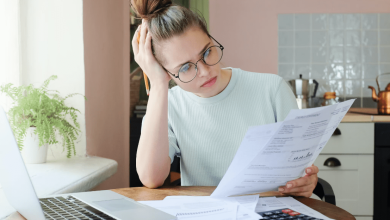Student Loan Debt Executive Order In The US 2024

Student Loan Debt Executive Order In The US 2024
President Biden’s pledge to erase $10,000 of student loan debt for low- to middle-class borrowers is fulfilled by a three-part strategy. Biden announced a student loan debt executive order of relief for those who most need it in 2024.
According to President Biden, going to college should be the ticket to a middle-class life. But for far too many people, the expense of taking out loans to pay for it prevents them from ever having that chance.
In June, the president declared that he would try to provide the relief in a different method following the Supreme Court’s decision to reject Biden’s scheme, which would have eliminated up to $20,000 in student debt for tens of millions of individuals.
This is what led to the sudden emergence of a newly developed student loan debt executive order in the US in 2024.
To work out the details, his administration already initiated the process and formed a “Student Loan Debt Relief Committee” that includes many student loan borrowers, Kyra Taylor from the National Consumer Law Center, and Wisdom Cole from the NAACP.
Executive orders, both historical and modern, are generally available online. Orders are frequently searchable by president, date, number, or subject. According to experts, the forgiveness process will certainly take longer.
This is the CBS News video of Biden, announcing another $1.2 billion in student loan forgiveness below:
Potential Qualified Borrowers
According to a recent study released by the United States Department of Education, the Biden administration appears to be focused on continuing to provide relief to five particular categories of borrowers. Which include:
1. Debtors in financial difficulty.
2. Debtors whose current balances exceed their original loan amount.
3. Those who started repaying their student loans at least 25 years ago.
4. Students who participated in programs of doubtful value.
5. Debtors qualified for existing relief programs, such as Public Service Loan Forgiveness, but have yet to apply.
Biden first tried to cancel student debt with an executive order in August 2022, promising borrowers relief within six weeks of completing their paperwork. As stated by a higher education specialist, the president’s Plan B for relief is likely to be far narrower in scope.
That’s because the court determined that the president’s first plan, which would have covered more than 90% of federal student loan borrowers, was too broad.
He’s now focusing on the regulatory procedure this time. That process takes longer and usually involves several procedures that require time, such as a public comment period.
He stated that debtors might receive their loan debt cancellation around the time of the 2024 presidential election if the administration is victorious this time.
Kantrowitz estimates that less than 10% of federal student loan holders will qualify for this round. According to him, “issuing new regulations can take as long as a year.”
An assistant professor of law at the University of Alabama believes the next forgiveness scheme will benefit significantly fewer borrowers.

What Is an Executive Order?
An executive order is a signed, written, and published instruction issued by the President of the United States to control federal government activities.
Executive orders are numbered consecutively, so they can be referred to by either their assigned number or their topic.
Other presidential documents, while similar to executive orders in type, formality, and issuing, have different functions.
Student Loan Debt Forgiveness Update
In January, the Biden administration announced that it would soon begin to cancel the debts of these borrowers who had signed up for its new scheme.
Over 150,000 debtors will have their $1.2 billion in school debt forgiven by the Biden administration. Borrowers who have been in repayment for ten years or more and borrowed $12,000 or less will be eligible for the relief.
The Biden administration announced Wednesday that it will forgive $1.2 billion in student debt for nearly 153,000 borrowers who have enrolled in its new repayment program, known as the Saving on a Valuable Education, or SAVE plan.
Miguel Cardona, the US Secretary of Education, stated in a statement:
“With today’s announcement, we are once again sending a clear message to borrowers who had low balances: if you’ve been paying for a decade, you’ve done your part, and you deserve relief.”
The U.S. Department of Education stated that eligible borrowers would begin getting emails from President Joe Biden on Wednesday and would not need to take any further action to receive the help.
The Biden administration has looked into every option to reduce educational debt after the Supreme Court rejected his comprehensive plan to forgive student loans in June of last year.
It has now eliminated debt for nearly 3.9 million borrowers, resulting in $138 billion in relief. The total estimated student loan debt outstanding(unpaid) is over 1 Trillion.
The Average Student Loan Debt In 2020
The National Center for Education Statistics (NCES) reported that the average student loan debt for a four-year bachelor’s degree was $30,500 in 2019-2020.
In 2021, the average student loan debt, which is currently $37,338, did not increase in value as much as in prior years. Private student loan debt increased at a significantly higher rate than federal debt in the US.
- Federal student loan debt averages $37,338 per borrower.
- Private student loan debt averages $54,921 per borrower.
- The average student borrows more than $30,000 to obtain a bachelor’s degree.
- There are 45.3 million borrowers with student loan debt, with federal loans accounting for 92% of the total.
- Half of student borrowers owe $20,000 or more on outstanding loan amounts 20 years after starting school.
The average student loan debt increased as total debt increased while the number of indebted borrowers remained relatively stable.
1. Since Spring 2021, the average student loan debt has risen by 2.74%.
2. Since Fall 2020, the average federal student loan debt has risen 5.9% from $36,520.
3. During the same year, the average private student loan debt fell by 14.58%, owing largely to Wells Fargo’s exit from the student loan market.
4. The typical monthly payment for student loan holders is $250.
5. University graduates owe an average of $33,500 every year after graduation.
6. The average private nonprofit university student borrows $33,700 to finish their bachelor’s degree.
7. For-profit students borrow $49,700.
8. All postsecondary students, including those pursuing certificates and associate’s degrees, borrow at least $15,000 to cover tuition.
Please keep in mind that this report’s categories and wording are consistent with the data source material.
Average Student Loan Debt by State
| State | Average Debt | Change Sep 2021-Sept 2022 |
|---|---|---|
| Alabama | $37,508 | +$365 |
| Alaska | $35,242 | +$1,269 |
| Arizona | $35,525 | +$97 |
| Arkansas | $33,830 | +$411 |
| California | $37,162 | +$346 |
| Colorado | $37,103 | +$243 |
| Connecticut | $35,588 | +$334 |
| Delaware | $38,373 | +$1,101 |
| District of Columbia | $54,668 | -$557 |
| Florida | $38,931 | +$349 |
| Georgia | $41,951 | +$320 |
| Hawaii | $37,097 | +$302 |
| Idaho | $32,972 | +$20 |
| Illinois | $38,198 | +$369 |
| Iowa | $30,580 | -$9 |
| Kansas | $32,922 | +$169 |
| Kentucky | $33,097 | +$253 |
| Louisiana | $34,827 | +$233 |
| Maine | $33,684 | +$476 |
| Maryland | $43,345 | +$376 |
| Massachusetts | $34,778 | +$380 |
| Michigan | $36,510 | +$259 |
| Minnesota | $33,852 | +$210 |
| Mississippi | $37,396 | +$410 |
| Missouri | $35,634 | +$146 |
| Montana | $34,056 | +$854 |
| Nebraska | $32,156 | -$89 |
| Nevada | $34,135 | +$179 |
| New Hampshire | $34,161 | -$13 |
| New Jersey | $36,172 | +$587 |
| New Mexico | $34,378 | +$122 |
| New York | $38,139 | +$203 |
| North Carolina | $38,134 | +$411 |
| North Dakota | $29,083 | +$479 |
| Ohio | $34,916 | +$151 |
| Oklahoma | $32,031 | +$382 |
| Oregon | $37,611 | +$293 |
| Pennsylvania | $35,695 | +$161 |
| Puerto Rico | $29,421 | +$1,372 |
| Rhode Island | $32,369 | -$48 |
| South Carolina | $38,682 | +$141 |
| South Dakota | $31,014 | +$113 |
| Tennessee | $36,730 | +$235 |
| Texas | $33,301 | +$293 |
| Utah | $33,110 | +$297 |
| Vermont | $36,943 | -$622 |
| Virginia | $39,561 | +$256 |
| Washington | $36,060 | +$400 |
| West Virginia | $32,174 | +$58 |
| Wisconsin | $32,289 | +$275 |
| Wyoming | $30,631 | -$793 |
| Other | $46,908 | +$1,115 |
Average Student Loan Debt by Institution Type
1. Students who used federal loans to attend public schools owe an average of $27,884.
2. The average student at a private, nonprofit university owes $40,607.
3. Students from proprietary or for-profit private colleges owe an average of $22,323.
4. Students at overseas colleges owe an average of $106,000.
5. A little more than 10 million students from various sorts of colleges owe an average of $5,090 in student loan debt.

Average Federal Student Loan Debt by Year
| Year | Total Loans | Stafford Loans |
|---|---|---|
| 2007 | 18,233 | N/A |
| 2008 | 19,297 | N/A |
| 2009 | 20,467 | N/A |
| 2010 | 21,860 | N/A |
| 2011 | 23,238 | N/A |
| 2012 | 24,757 | N/A |
| 2013 | 26,267 | N/A |
| 2014 | 27,759 | 20,054 |
| 2015 | 29,144 | 19,902 |
| 2016 | 30,548 | 20,676 |
| 2017 | 32,086 | 20,818 |
| 2018 | 33,547 | 20,863 |
| 2019 | 35,205 | 20,829 |
| 2020 | 36,510 | 21,520 |
| 2021 | 37,112 | 21,639 |
| 2022 | 37,574 | 21,663 |
Average Student Loan Debt by Age
1. Those aged 50 to 61 have the highest average student loan debt, $45,600.
2. Adults under the age of 25 account for 6.05% of total federal student loan debt.
3. Adults aged 25 to 34 account for 30.2% of federal student loan debt, with 35 to 49 accounting for 38.9%.
4. Borrowers aged 50 and older account for 24.9% of total federal student loan debt.
5. In 2005, students under 30 borrowed $147 billion ($258 billion after inflation).
6. In 2018, students under 30 withdrew $124 billion ($148 billion after inflation).
7. In 13 years, the value of student loan originations among borrowers under 30 years old fell by 42.6%.

Average Student Loan Debt by Race or Ethnicity
1. Over 12 years, the typical Black woman’s student loan debt amount increased by 13%.
2. Over 12 years, black men’s average debt balance increased by 11%.
3. The average federal student loan debt among Black and African American borrowers is $27,260, the most of any race group.
4. The typical white student owes $21,578.
5. Asian students borrow the most among part-time or part-year undergraduates, with an average of $10,698.
Average Student Loan Debt Among Graduate Degree Holders
| Degree | Total Student Loan Debt | Graduate Debt Only |
|---|---|---|
| Postbaccalaureate Certificate | $82,819 | $67,376 |
| Master’s | $91,785 | $71,361 |
| Master of Arts | $89,046 | $65,881 |
| Master of Business Administration | $81,075 | $62,394 |
| Master of Education | $67,500 | $52,057 |
| Master of Science | $76,218 | $59,779 |
| Doctorate, Research | $136,869 | $126,656 |
| Doctorate, Professional | $228,156 | $213,834 |
| Doctor of Education | $136,869 | $126,656 |
| Medical Degree | $300,887 | $277,847 |
| Law Degree | $177,967 | $161,029 |
Average Student Loan Debt by Sex or Gender
1. Women account for 64% of all student loan debt, with Black women having the greatest average amount.
2. Student borrowers who identify as LGBTQ have an average of $16,000 more in outstanding debt than those who do not.
3. In a poll, indebted student borrowers who chose various genders had the greatest outstanding debt.
4. Male borrowers are less likely to have large levels of student loan debt.
5. Female borrowers are more likely than male borrowers to have student loan debt from graduate school.
Note that the quantity of survey responses from students who identify as transgender or select “a different gender identity” is insufficient to generate meaningful results. Some sites use the words “sex” and “gender” interchangeably.
Average Student Loan Debt by Educational Attainment Level
1. Borrowers of federal student loans for undergraduate and higher education owe an average of $33,448.
3. Borrowers with master’s degrees owe an average of $80,494.
4. The average law school debt is around $180,000.
5. The average medical school debt is more than $200,000.

Excellent Online Repositories of Executive Orders Include:
https://www.whitehouse.gov/briefing-room/presidential-actions/
Executive orders from the current presidential administration are available as PDFs from the White House press office.
2. National Archives and Records Administration
https://www.archives.gov/federal-register/executive-orders/
Archive of all things related to the U.S. government, the National Archives maintains a digital index of executive orders that is searchable by date, number, or topic. Orders may be viewed as PDFs or text, in the Federal Register, or within Title 3 of the U.S. Code.
3. American Presidency Project
http://www.presidency.ucsb.edu/executive_orders.php
The University of California, Santa Barbara maintains an archive that includes the text of practically all executive orders, searchable by year of issue dating back to the early nineteenth century.
Student Loan Debt Relief Application
Visit StudentAid.gov/debtrelief to learn more about the actions President Biden announced following the decision and find out how to apply.
FAQs
How will I know if my student loan will be forgiven?
If you are eligible for loan forgiveness under PSLF, Teacher Loan Forgiveness, or IDR discharge, your loan servicer or Department of Education will send you a notification letter.
Depending on your account preferences, you may receive the letter electronically or in the mail.
How can I get out of student loan debt?
- Organize your student loan debt and make a repayment plan.
- Pay more than the minimum due.
- Leverage tax deductions and credits.
- Make additional payments.
- Apply for loan forgiveness.
- Make biweekly payments.
- Take advantage of interest rate discounts.
Are student loans still on hold?
The U.S. Department of Education’s COVID-19 relief for student loans has ended. The 0% interest rate ended Sept. 1, 2023, and payments restarted in October.
Should I pay off my student loans or wait for forgiveness?
It may be wise to just keep paying your student loans on time and perhaps wait to see if this new student loan forgiveness program can get some of your balance forgiven eventually.
This is a perfect reason to not rush on your student loan payments and prioritize other investments or payments that are more urgent.
Why is my student loan balance zero?
If your student loan balance is suddenly zero, it could indicate that your federal or private loans have been forgiven.
You have finished one of the student loan forgiveness programs. You are eligible for Public Service Loan Forgiveness (PSLF).













